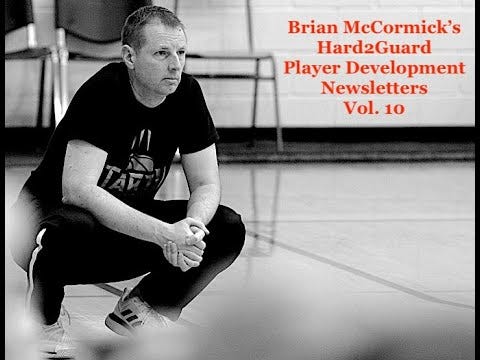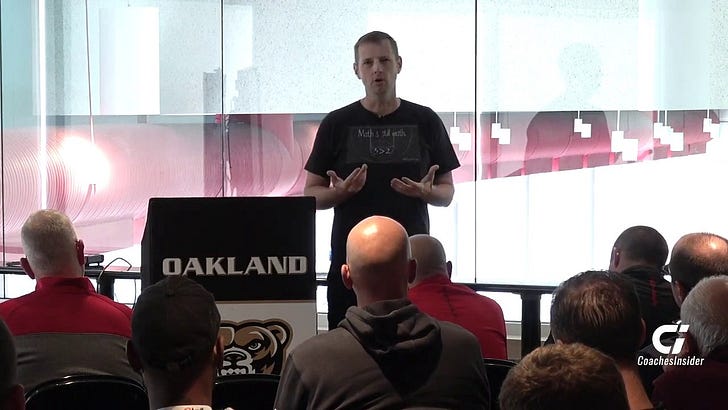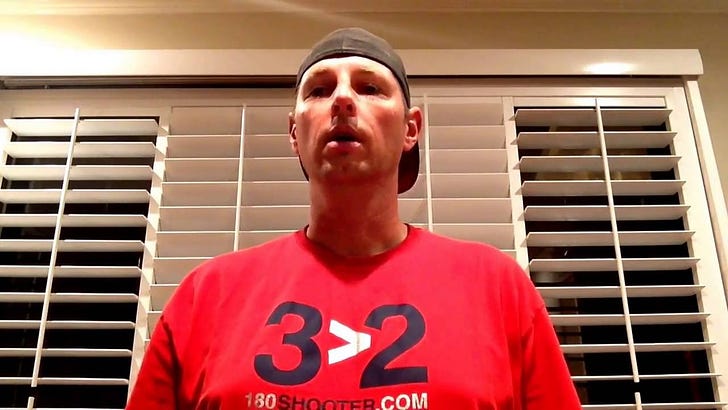The Mile Test, Attributions of Success, and Social Media
Did University of Houston reach the NCAA Championship Game because they ran the mile, move a lot of weight in the weight room, eat well, are loud in practice, or close out better? Yes.
People immediately attributed University of Houston’s epic comeback against Duke University in the NCAA Men’s Basketball Semifinal to their preseason mile test last August. One tweet read, “Did the fact that Houston’s men’s basketball team averages 5:19 for the mile come into play in that fantastic finish? Endurance pays off at the end of games.” Duke also used the preseason mile test. Why did the endurance pay off for one team but not the other? Furthermore, Houston was on the wrong side of the comeback two nights later in the championship game. Why did their endurance not pay off against the University of Florida?
I have written about the preseason mile test previously in Fake Fundamentals, Volume 1, and have no interest in rehashing the arguments. Many successful teams use the mile or two-mile preseason test. Many bad teams use the same tests. As associate professor of football and researcher Mark O’Sullivan said, “Talent is the graveyard of evidence; nobody sees the dead bodies.”
The discussions largely demonstrated two problems in talent development today: First, attributing team sport success to a single cause; and second, social media’s outsized influence on training programs. As I wrote previously:
“Not every single thing an NBA player did contributed to his success. Dwight Howard notoriously was addicted to sugar: He ate the equivalent of 24 chocolate bars’ worth of sugar every day. Should we encourage youth players to binge sugar because it worked out in the end for Howard? You laugh, but why is attributing a player’s success to his diet any less valid than one aspect of his training, whether playing soccer, training individually, playing AAU, or running a mile every day in the offseason? Coaches hear about an NBA player running a mile every day in the offseason and many nod in agreement, and maybe even use the story to motivate their players to run a mile every day. Why not encourage more sugar in their diets? Howard is a first-ballot Hall of Famer: Shouldn’t we learn from him and copy his approach?”
Everyone discusses the training secrets of the winners, hoping to glean the secret of success, but the unsuccessful do many of the same things. Winning a basketball game or a championship is not due to a single factor; success is multifactorial. Attributing a win or a championship or success in general to a single cause is simple-minded.
The University of Houston’s strength coach is active on social media. He is probably the best strength and conditioning coach in college basketball. During Houston’s run to the championship game, many used the team’s shirtless pictures to demonstrate the the weight room’s necessity for basketball players, and he emphasizes the players’ diet and nutrition more than any strength coach I have seen. The mile test likely is a very small piece of his overall program, but many highlight it to serve their narrative.
Others attributed Houston’s success to their practices, and especially a popular social media drill with players diving for loose balls. Others highlighted their practice intensity, as demonstrated by the volume of feedback during a passing drill. Others noted their closeouts to take away three-pointers rather than chopping their steps (Fake Fundamentals, Volume 1). One successful team served dozens of narratives. None is wrong, but none is the sole cause of their success.
These social media discussions often become the marketing of ideas and specific training programs promising similar results. Nuance is lost. People search for the way and find it when visible, well-followed accounts promote drills or training ideas from successful programs; celebrity has become synonymous with expertise.
The worst college basketball team in the country will not turn around its program by incorporating a mile fitness test next August, but many imply this, ignoring the graveyard of evidence. Many hear the attribution of Houston’s success to the preseason mile test and believe they must train for this test; many teams run mile after mile in the offseason, and others encourage players to run cross country to prepare for basketball. Steve Magness, author and former track & field coach at Houston, tweeted about my previous article. He wrote, “I think his [my] premise is also false. No one is suggesting to train like a HS XC runner for basketball.” Why use a mile test and not incorporate long-distance training?
Without knowing the training programs for every program using the preseason mile test, there are two general possibilities:
Teams train specifically for the mile test.
Teams do not train specifically for the mile test.
Is training specifically for the mile test the best use of time and energy? College coaches have more time with players throughout the year than do high school coaches, yet still feel they do not practice enough. If I lacked sufficient practice time, whether for strength and conditioning or on the court, I would subtract endurance first. I am more interested in power, speed, and strength, but I also scrimmage more than most and do not use practice players, managers, ball machines, and other substitutions for players during practices. I trust practice to provide a sufficient conditioning stimulus.
Why conduct a mile test without training for the test? Many suggest toughness, camaraderie, and other reasons. That is not my style, but many successful coaches embrace this style. To each his or her own.
However, what have we learned when players run good mile times without training for the test? Playing and practicing basketball leads to very good, but not elite mile performances. This is not overly surprising.
What is the purpose of a physical test such as the mile, squat, or bench press test? Coaches have their own reasons, but often the purpose is to set a baseline to measure the progress of a training program. Some tests, especially a mile or two-mile test, are used to motivate players during offseason workouts; to measure their adherence to training when away from the program and to punish those who did not train sufficiently. People also seem to ascribe a host of other purposes to the mile test, from mental toughness to team camaraderie, and more.
Many successful coaches incorporate tests for any and all of these reasons. I have worked as a junior-college strength and conditioning coach and a strength coach for my own teams. When employed as strictly a strength coach for another basketball coach, I test to provide the coach with information or based on the coach’s requests. As my own strength coach, I generally do not test much because I see the results every day on the court. I do not need a mile test to tell me who is and is not in shape or a sprint test to tell me who is fast. Running and lifting weights are tools to enhance basketball performance. I measure success by on-court performance, not a single day of physical testing.
Testing should provide information or feedback about the current state of players (baseline) or the effectiveness of a training program or block (pre- and post-testing). Testing can be used as a needs assessment to determine which players need what type of training. What is the purpose of the testing when it is not used to set a baseline or measure the effectiveness of a training program (or used for competitive comparisons, such as the NBA combine)?
I use on-court performance rather than physical testing to inform our training programs. I regularly text my strength coach during or after a workout with suggestions or needs for a player heading to the weight room. One player needs more ankle mobility because his previous ankle sprain is hindering his shooting (let’s try more single-leg work); another player needs some extra coordination work (let’s try Olympic lifts or medicine ball throws); another player needs a stronger core (let’s add crawling). On-court performance becomes our testing rather than speed, strength, or endurance tests. On-court performance is the needs assessment.
During my first year as a women’s basketball assistant, the head coach used a mile test in the very first workout. The test was meant to motivate players to work out over the summer and the results were used to punish players who did not pass. Those who passed were able to practice; those who did not pass, worked out at 6 A.M. until they passed. We could have determined who was and was not in shape with a five-minute scrimmage or probably any single basketball drill. The test was not to get information or to determine future training.
We had no true strength and conditioning program; we had players who practiced, and players who were punished. We committed 50 turnovers in a game that season; fitness, especially in August, was not the team’s limiting factor. Did the mile test, the punishments, and preventing players from practicing increase our chances for success with a group that struggled to complete passes? Were there not better uses of this time than punishing players on treadmills?
Too often, physical tests are used as consequences. These creative negativity from the first day. I understand holding players accountable for their time spent away from the team’s training, but I prefer to create an environment that motivates players to practice and train for themselves and their teammates, not to pass a test. I want players striving to maximize their training, not training to achieve a minimum score.
Most players who play and practice a lot will pass a mile test, so it is not a big deal. However, what is the point? If we know our players are in shape because we work with them all summer, like college programs, what are we learning from the tests? Is it simply team camaraderie? Are there better, more interesting ways to build camaraderie?
As legendary athletic development coach Vern Gambetta has said, “No one workout can make an athlete, but one workout can break an athlete.” A single drill, workout, or test is not the reason for a college program’s success, but competitive testing without proper preparation can expose players to injuries; for instance, a slight hamstring pull during a professional team’s preseason camp can linger throughout a season, as happened to my best player a few seasons ago, with enduring negative consequences (performance, missed games) throughout the season.








So much to unpick here (as always).
I think athletes will train to the test, so coaches need to be careful what test they choose. If you set a mile-run, then the keen athletes will do 'extras' to be better at that test. Training for a mile is not the same as training for a basketball match (even though some aspects are similar). Do you want your basketball players running 3-10 miles to build up their aerobic base?
As for coaches copycatting other coaches without understanding the 'Why', that seems to be the norm nowadays. If you can't explain why you are doing something to your team, don't do it! (not limited to basketball).